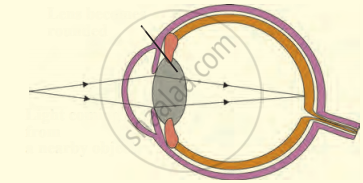Advertisements
Advertisements
प्रश्न
What happens to the image distance in the normal human eye when we decrease the distance of an object, say 10 m to 1 m? Justify your answer.
उत्तर
If the object distance is greater than 25 cm the image is always formed on the retina as the focal length of the human eye lens gets adjusted depending on the object distance. This special property of the human eye is called as power of accommodation. Hence, image distance will remain the same if object distance changes from 10 m to 1 m.
APPEARS IN
संबंधित प्रश्न
With the help of ciliary muscles the human eye can change its curvature and thus alter the focal length of its lens. State the changes that occur in the curvature and focal length of the eye lens while viewing (a) a distance object, (b) nearby objects.
Name two types of cells in the retina of an eye which respond to light.
Fill in the following blank with suitable word:
To bring light from a near object to a focus on the retina of the eye, the convex eye-lens need to be made....................
Note the relationship between the first two words and suggest the suitable word/words for the fourth place.
Cones : Iodopsim :: Rods : ______.
Name the muscles of the eye responsible for the power of accommodation.
Name the following:
Yellow spot and ciliary muscles are found in.
Name the following:
The type of lens used for correcting myopia.
The following figure show the change in the shape of the lens while seeing distant and nearby objects. Complete the figures by correctly labelling the diagram.

Arrange and rewrite the term in group in correct order to be in a logical sequence, beginning with the term that is underlined:
Pupil, Aqueous humour, Retina, Vitreous humour.
The layer in the eye where sensory cells (rods and cones) are located ______.
